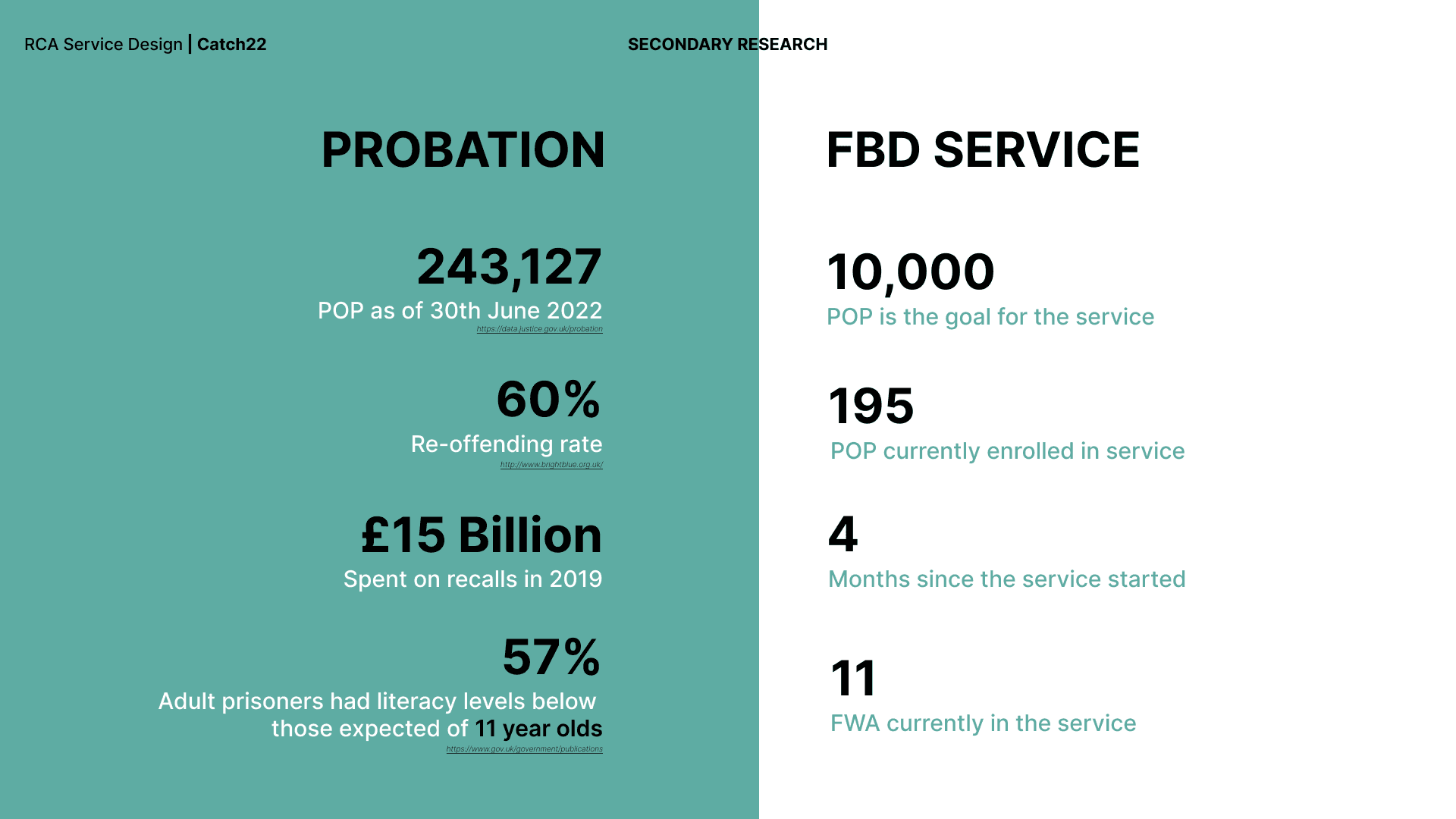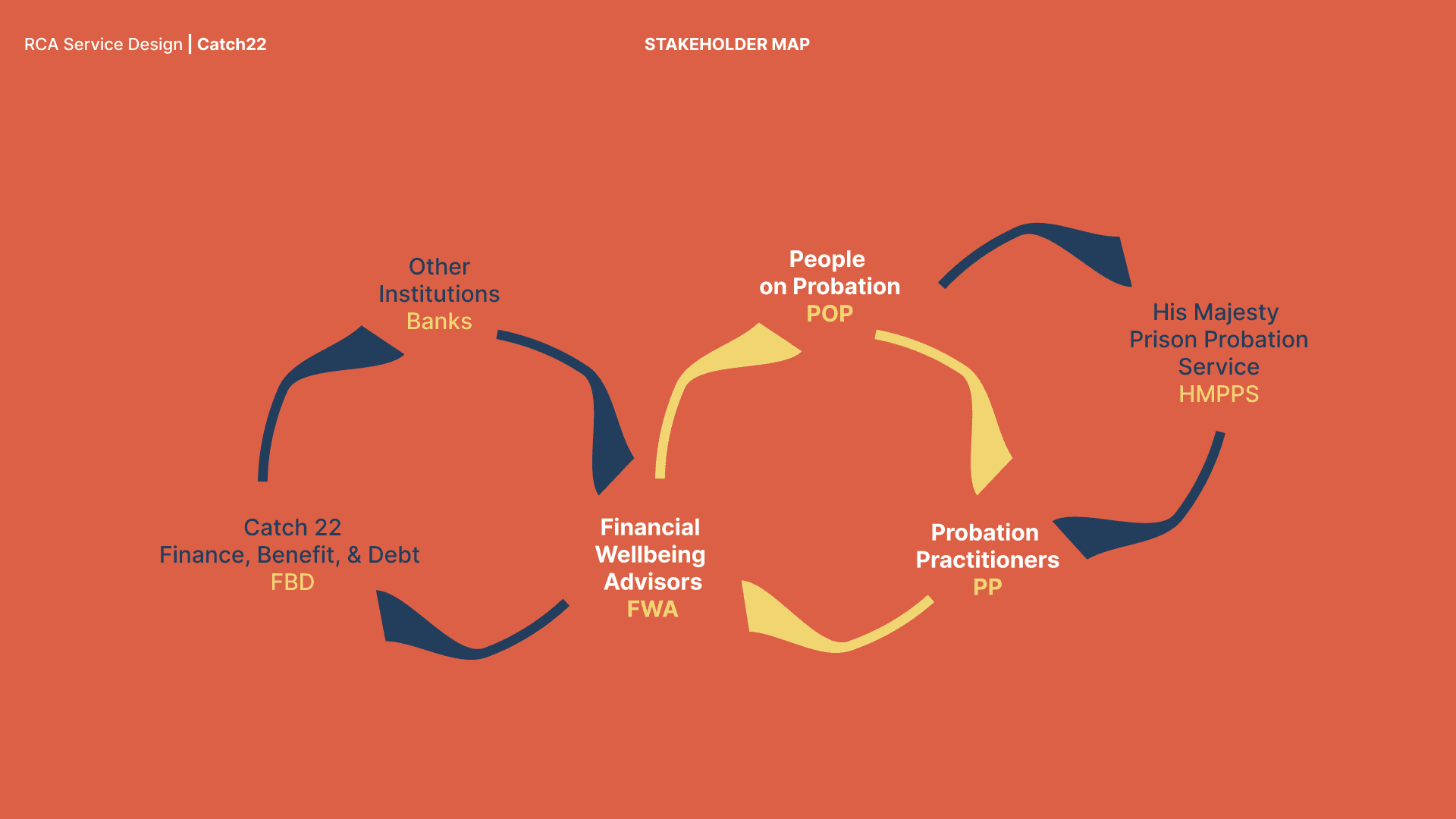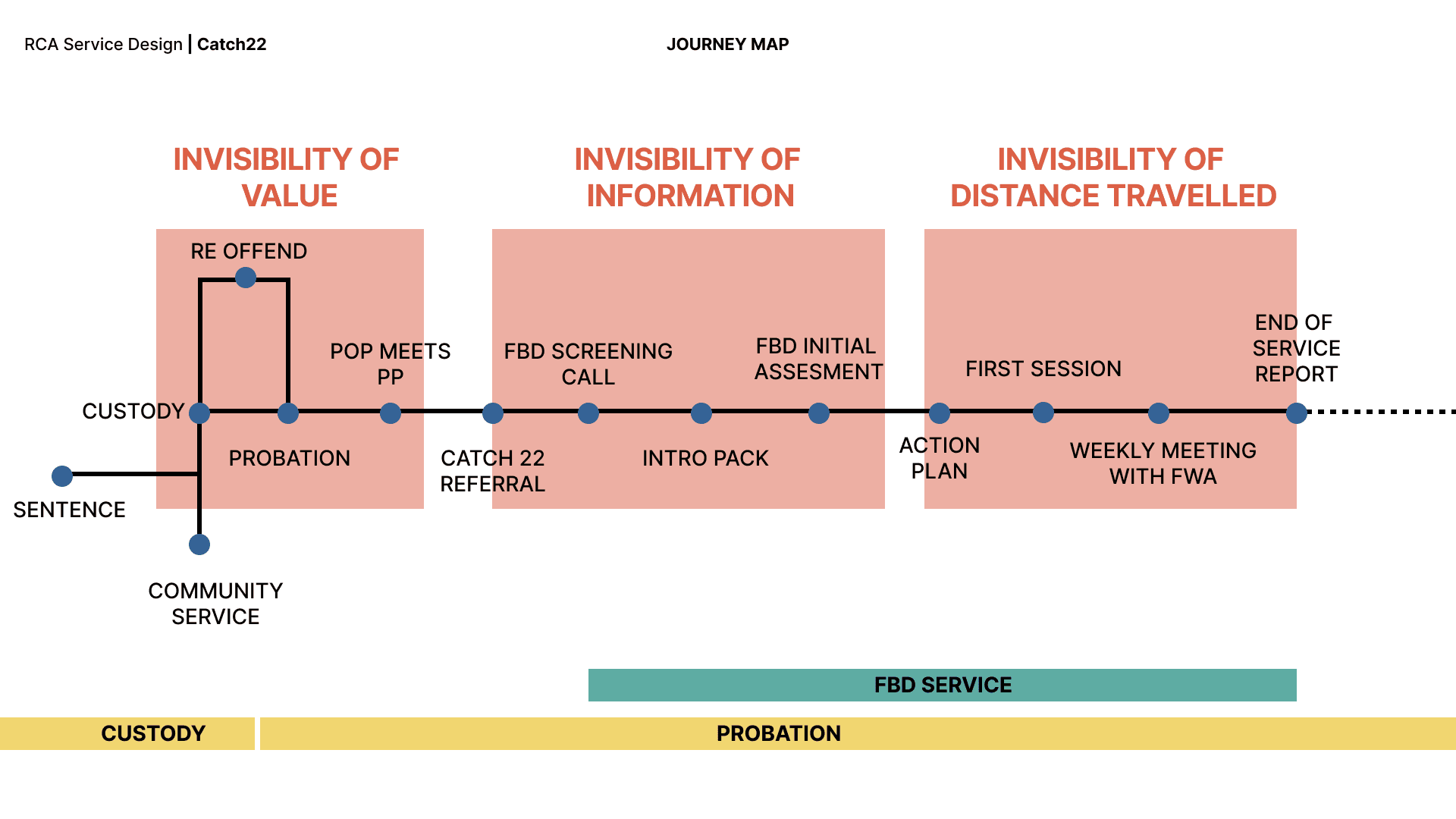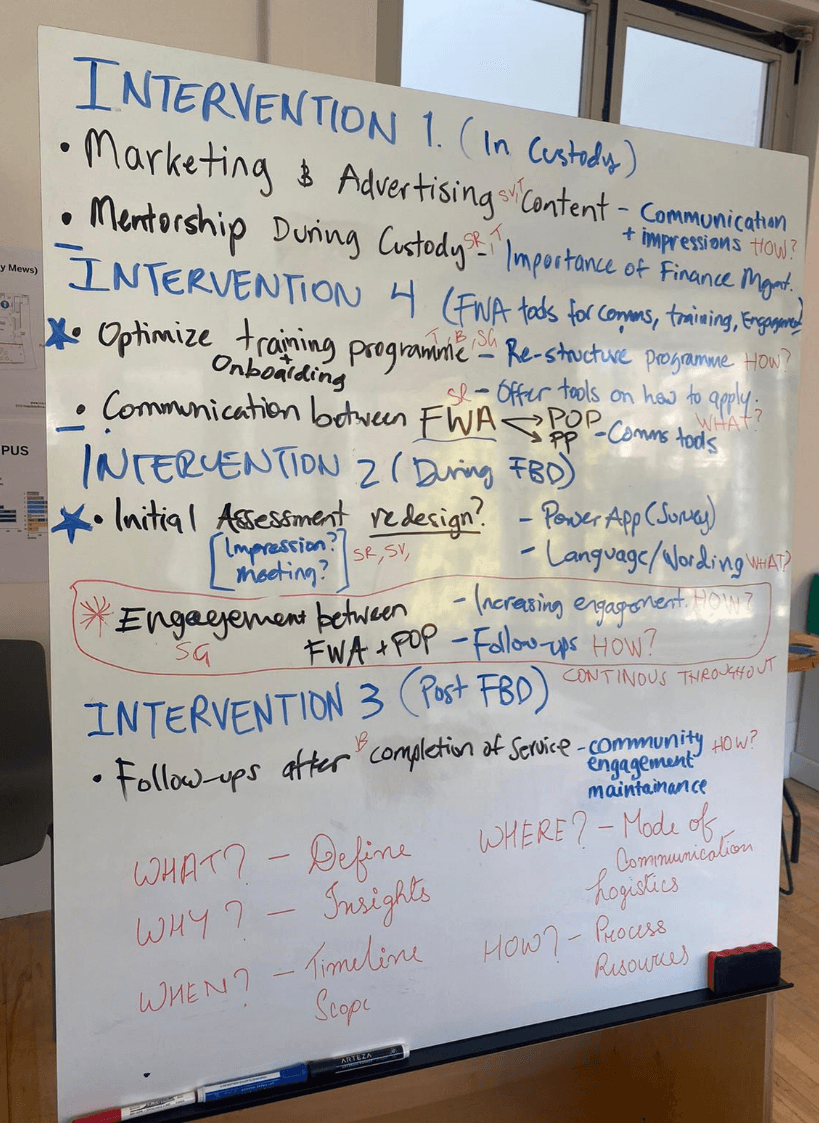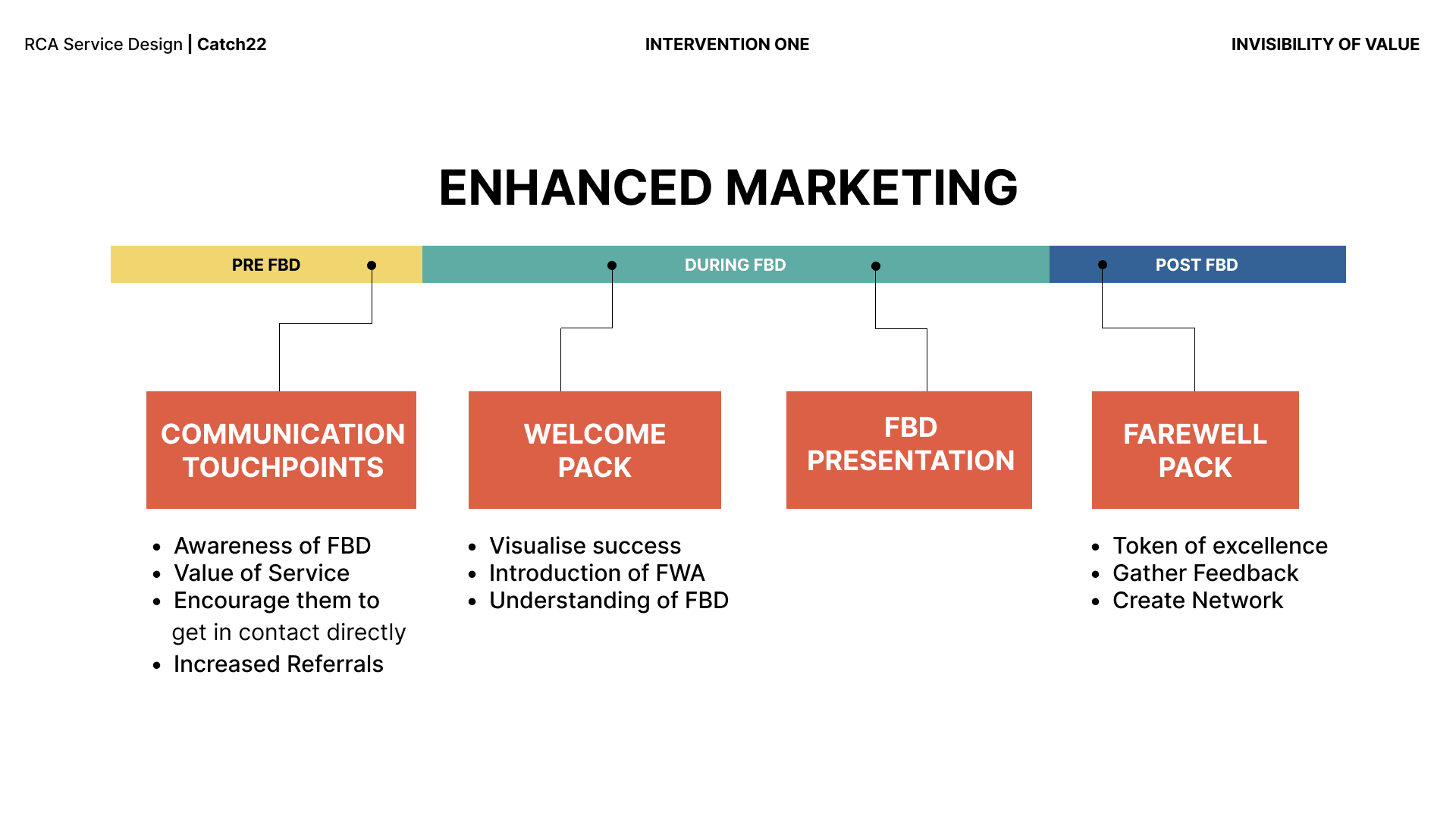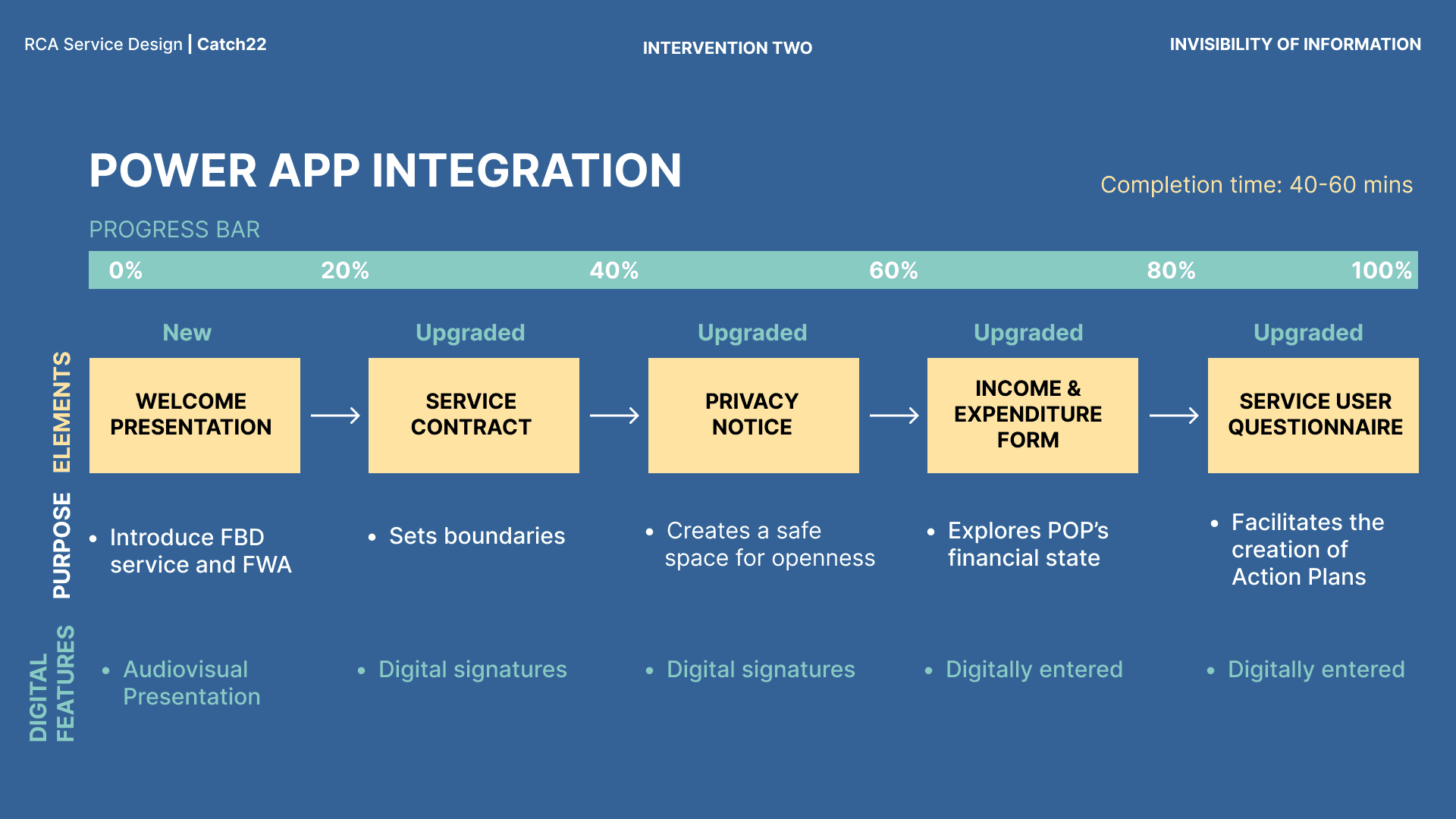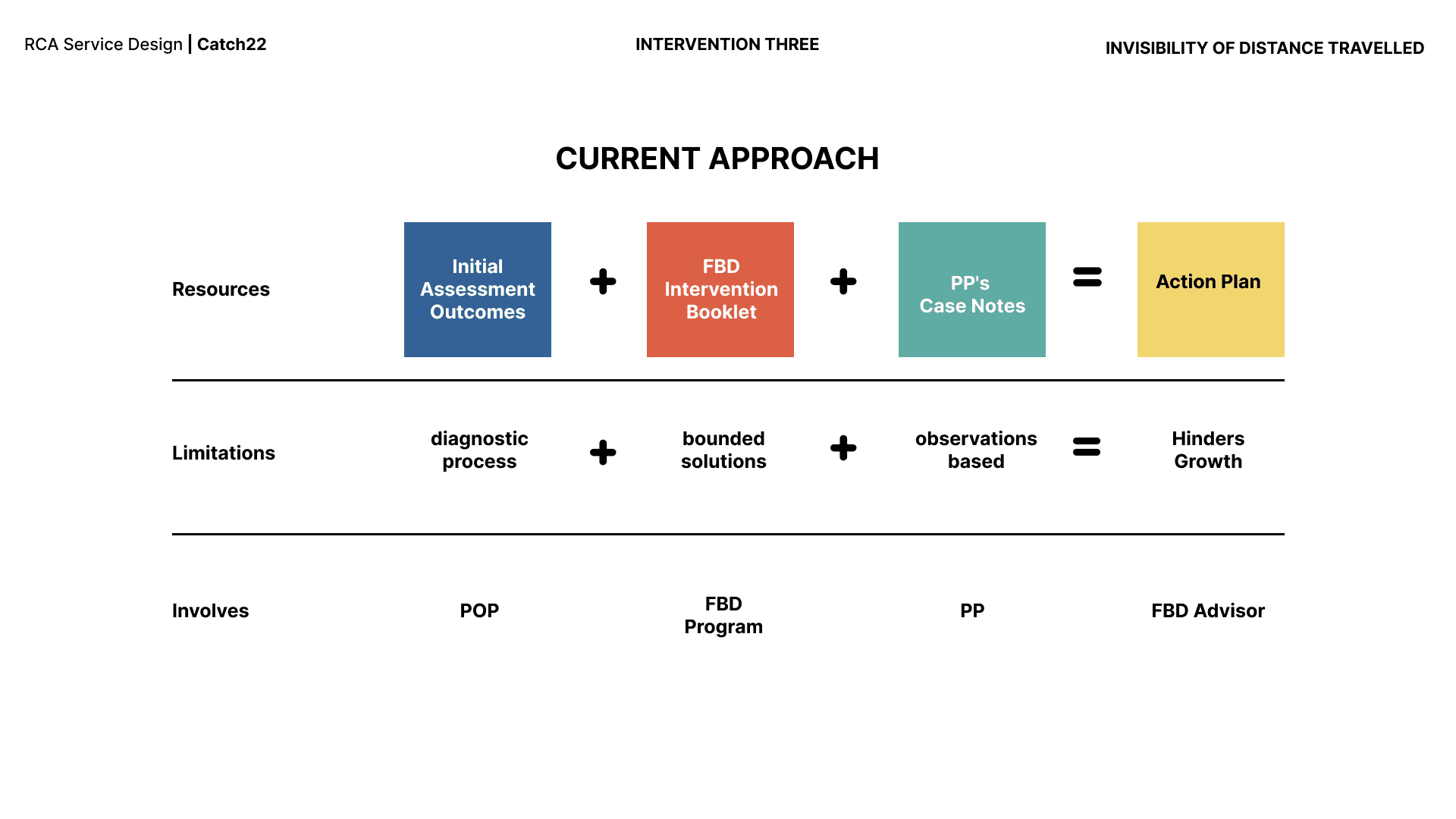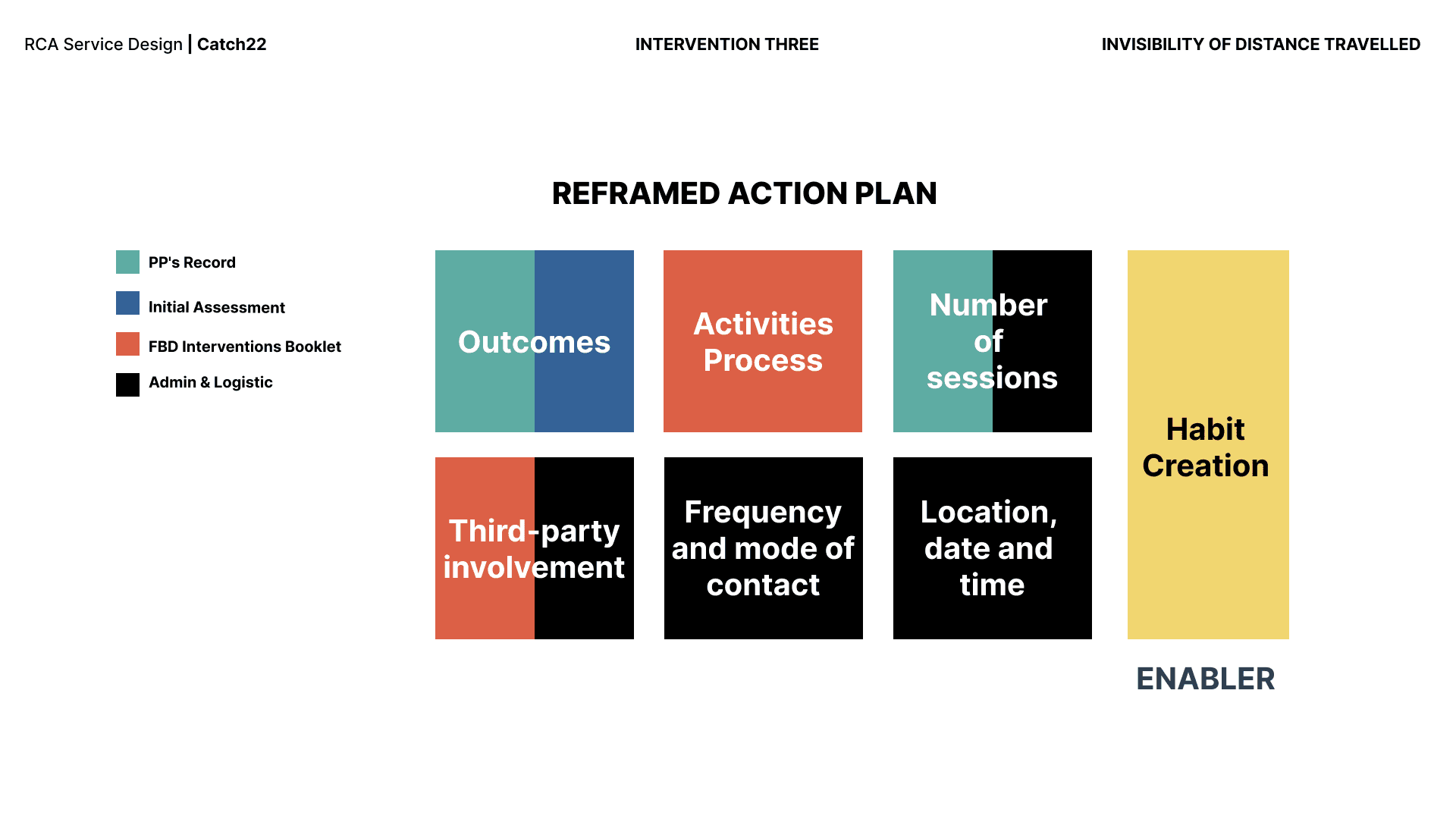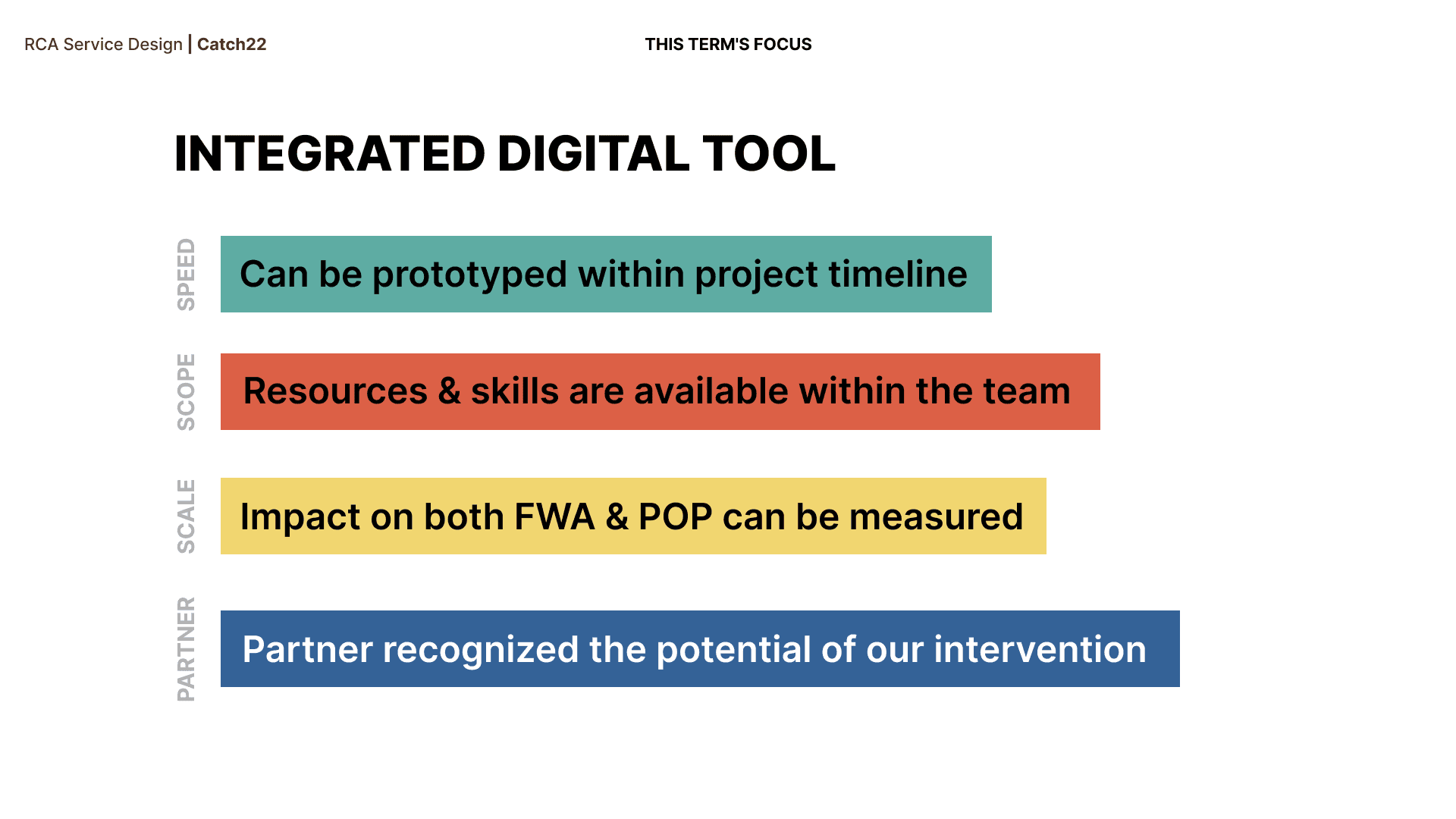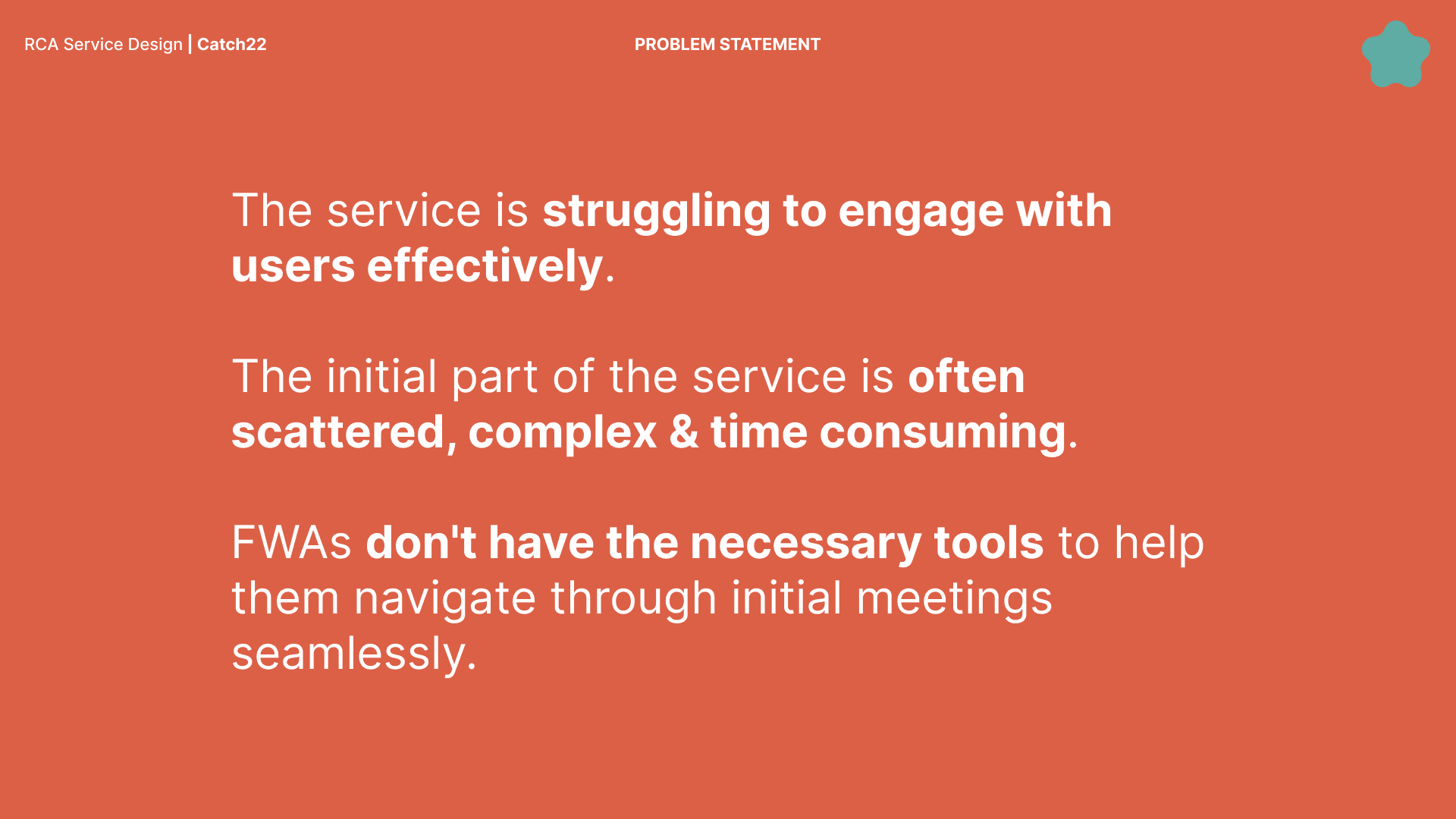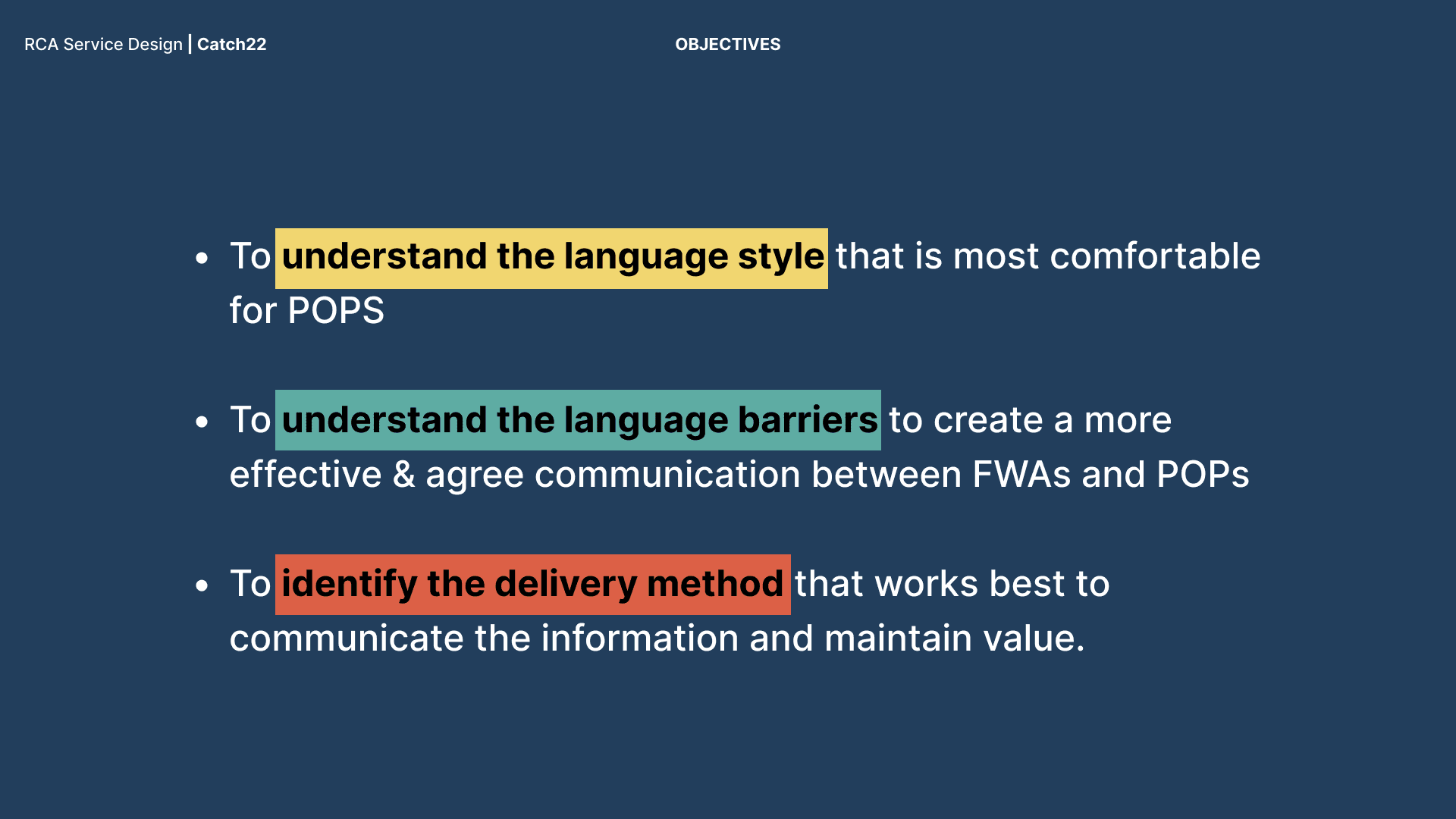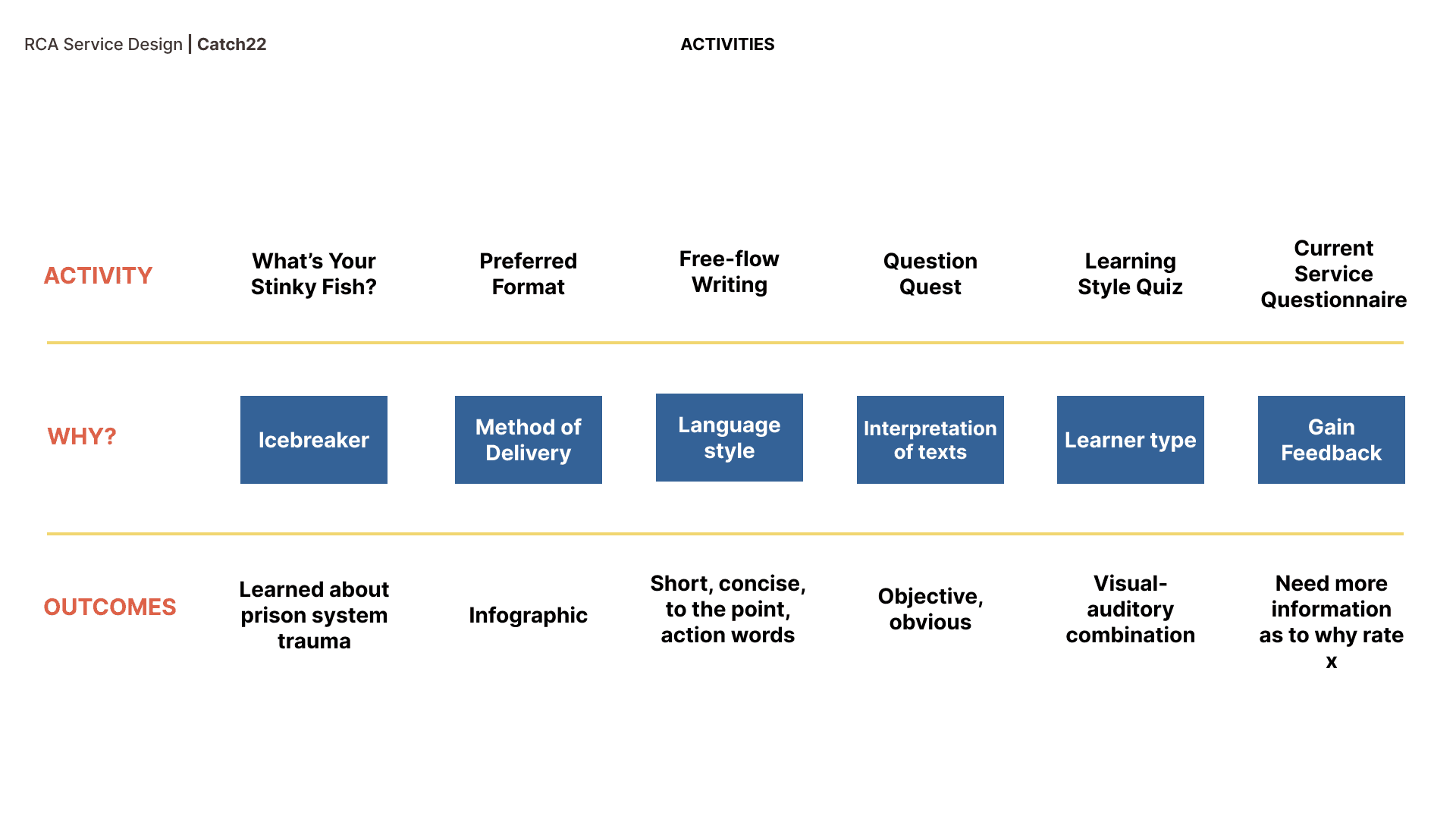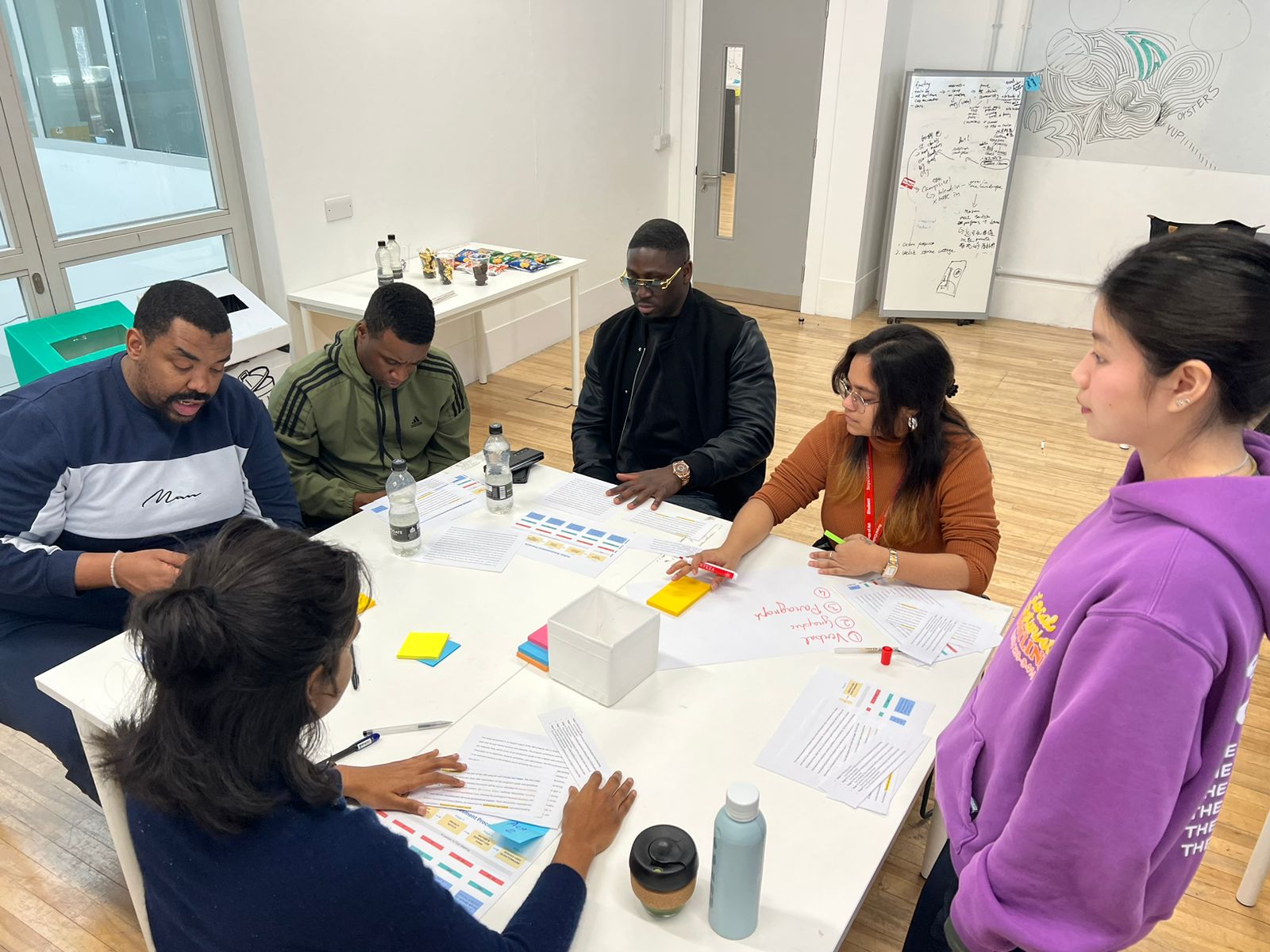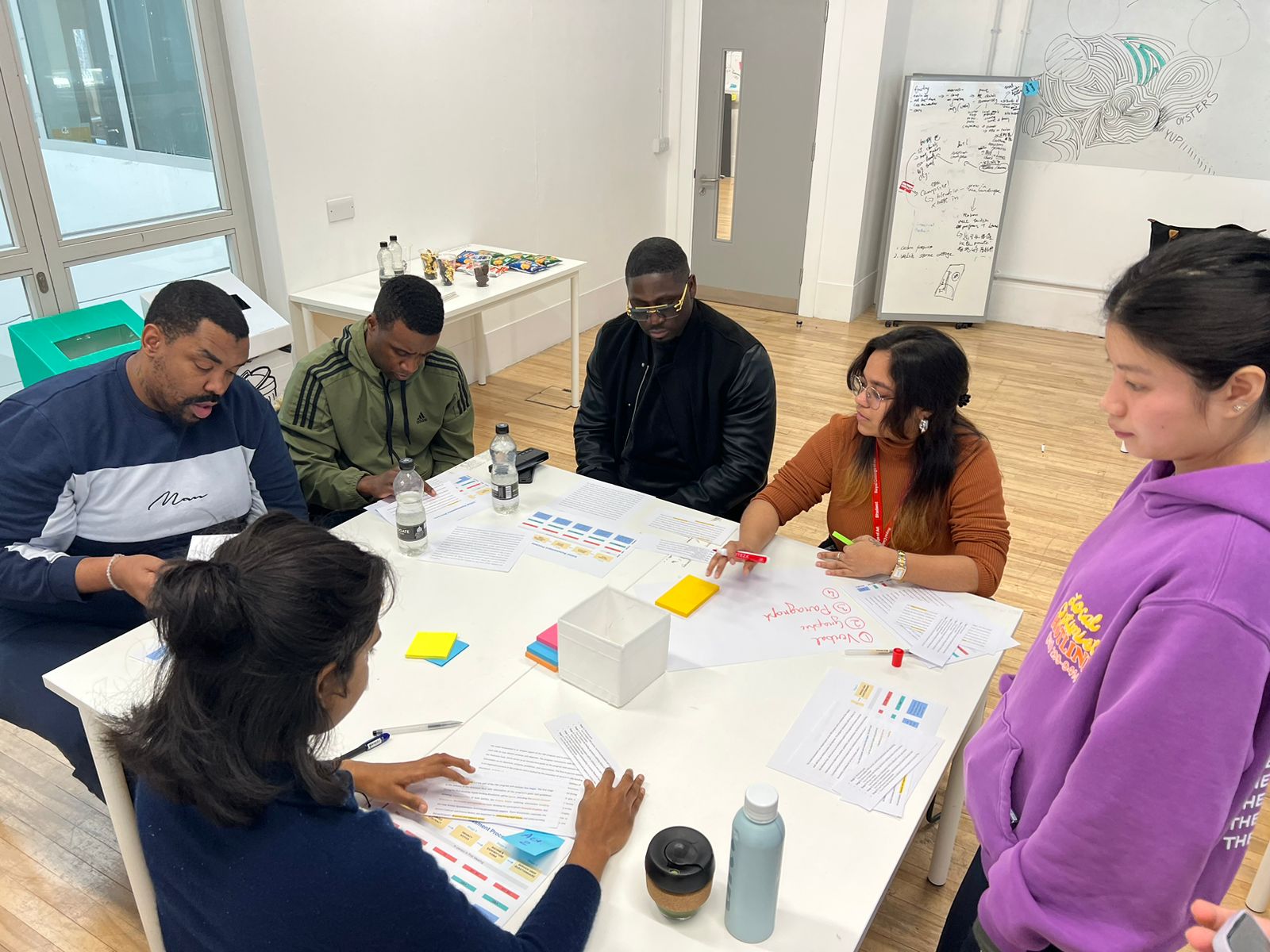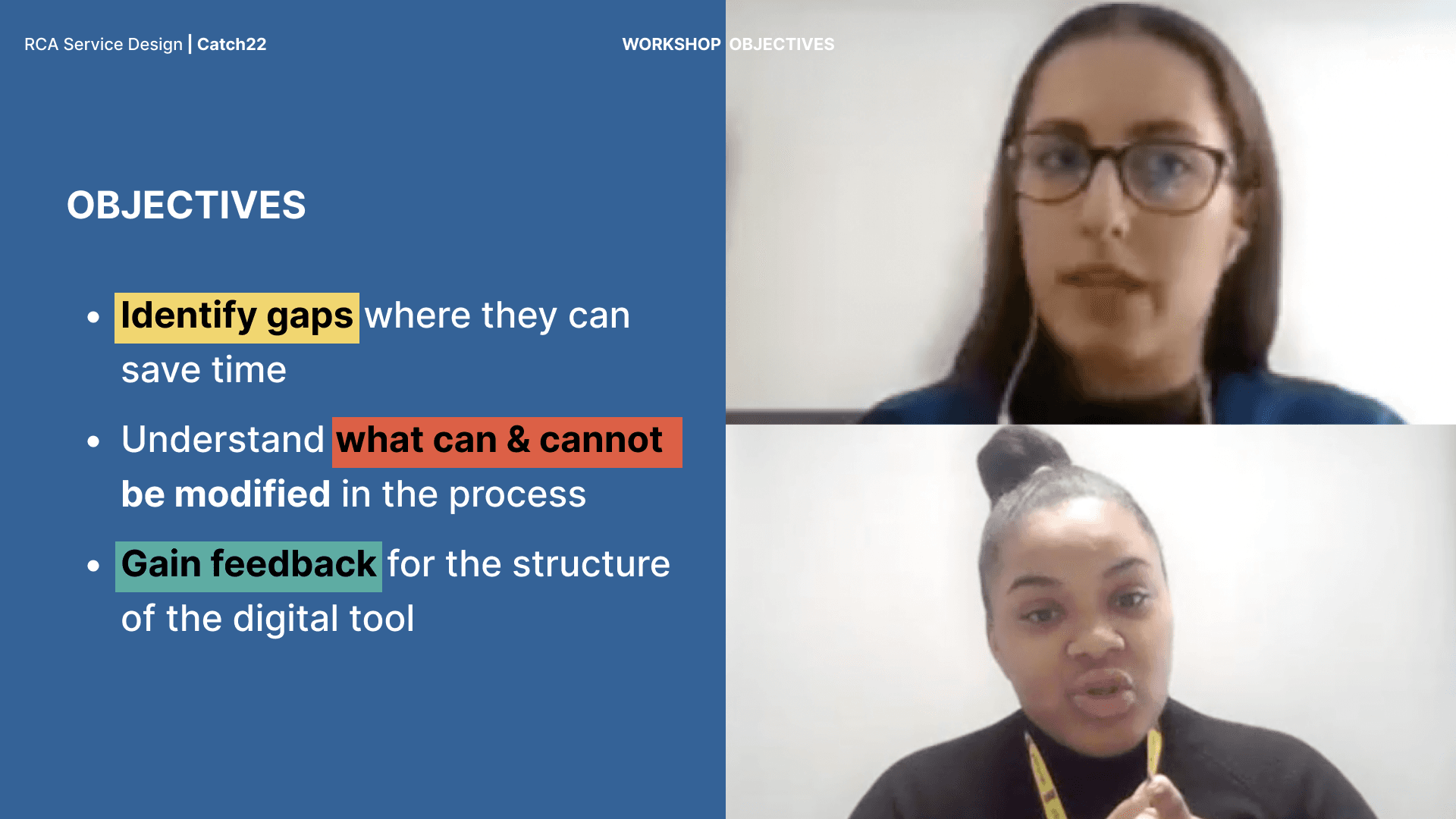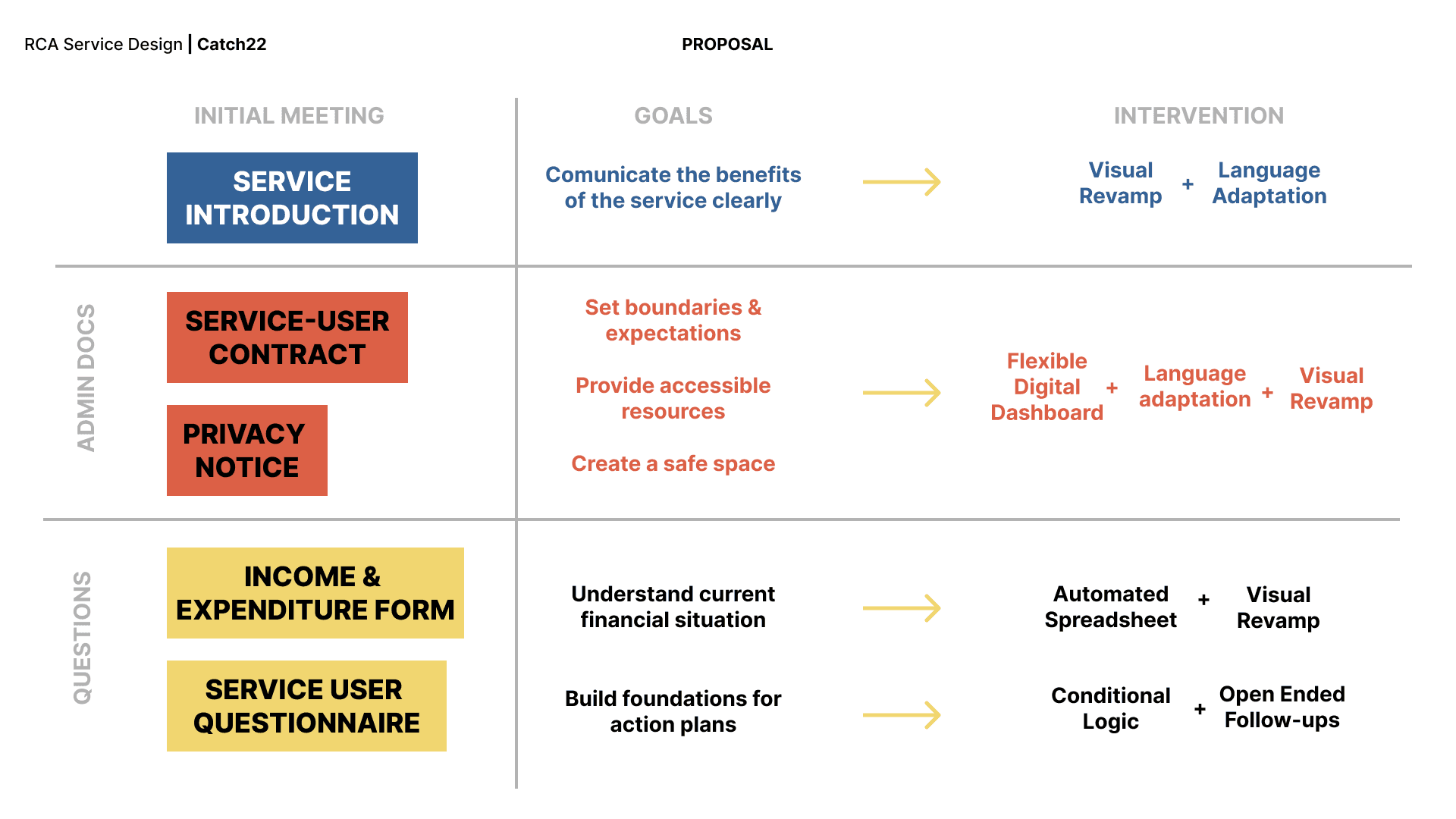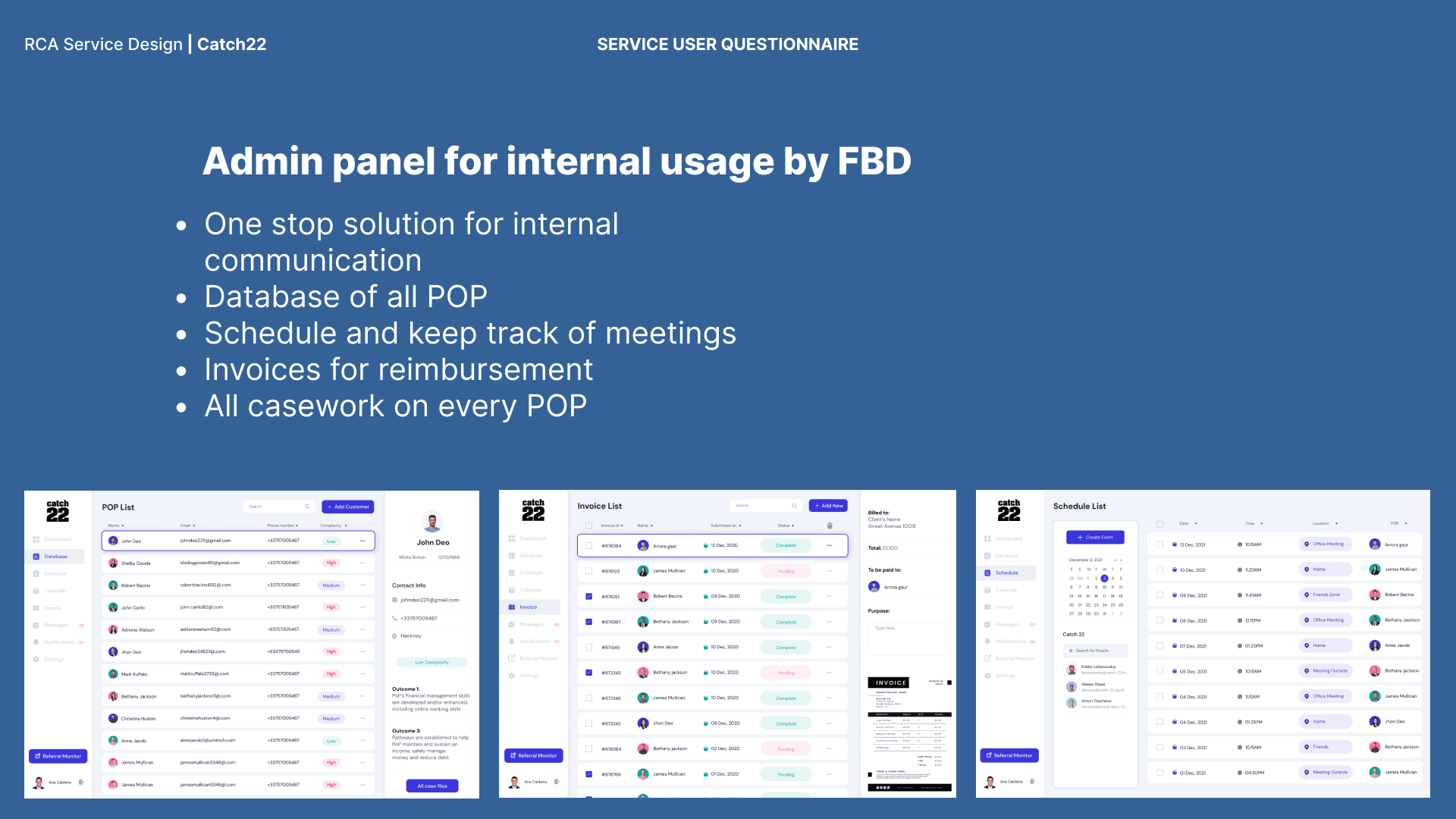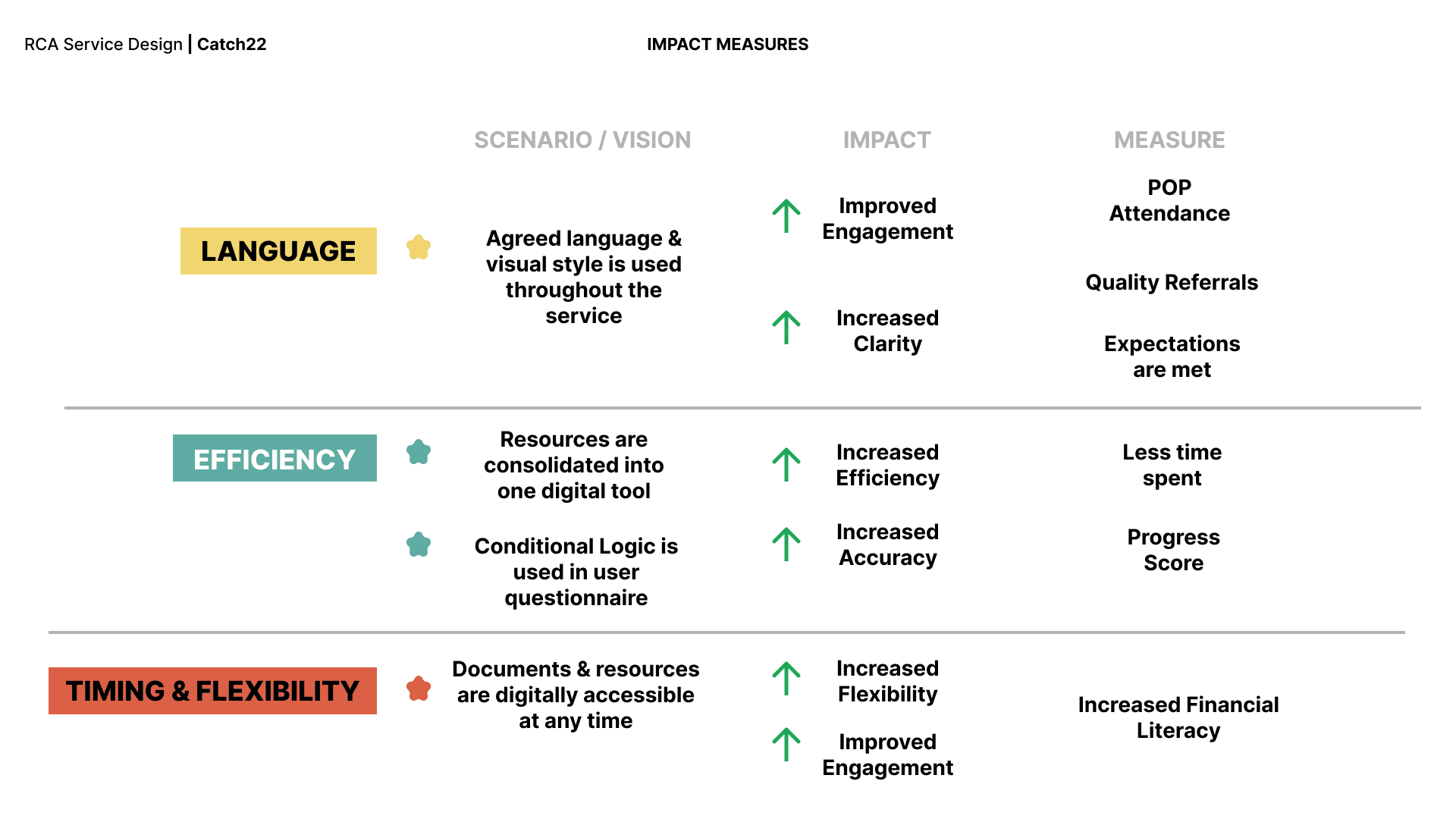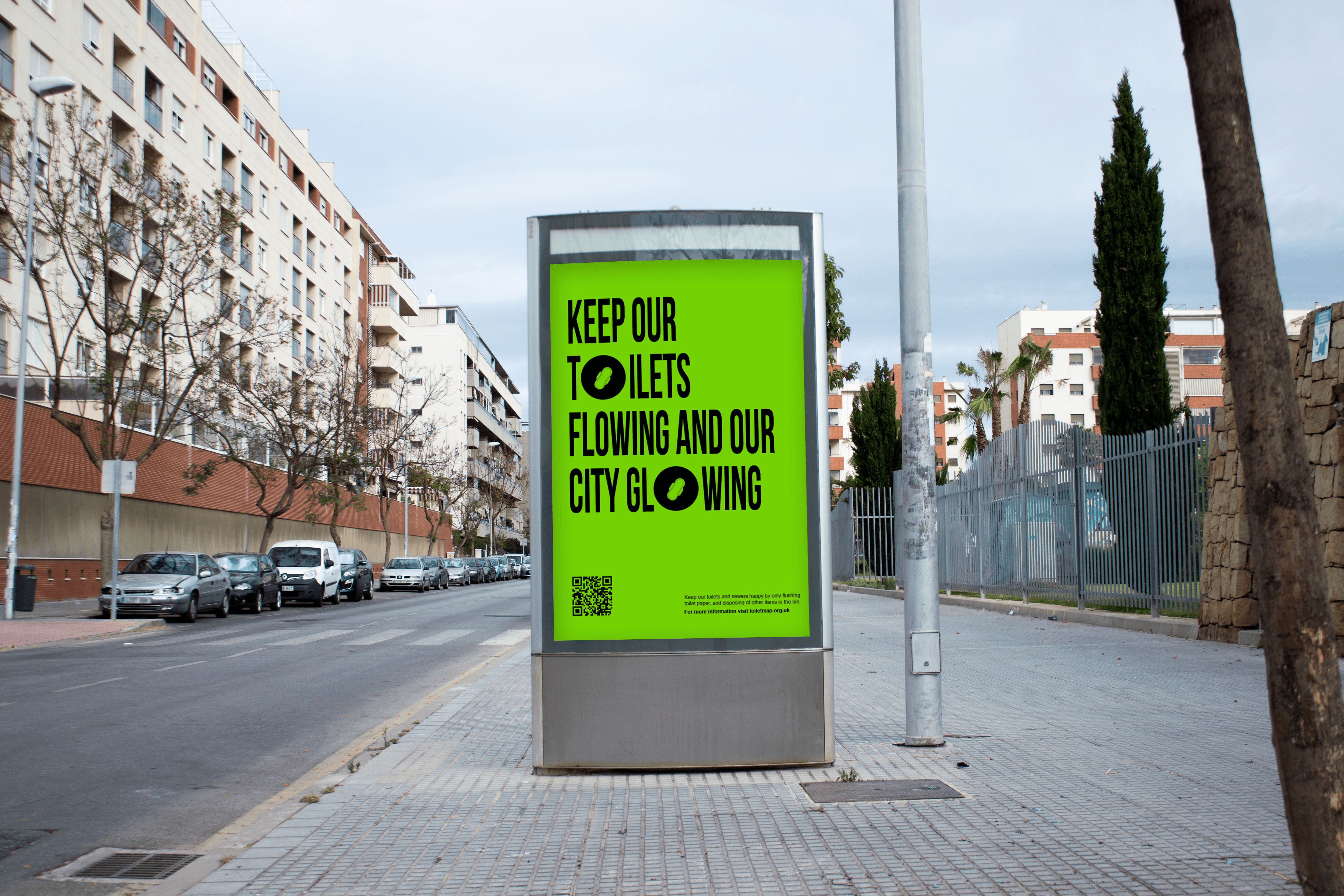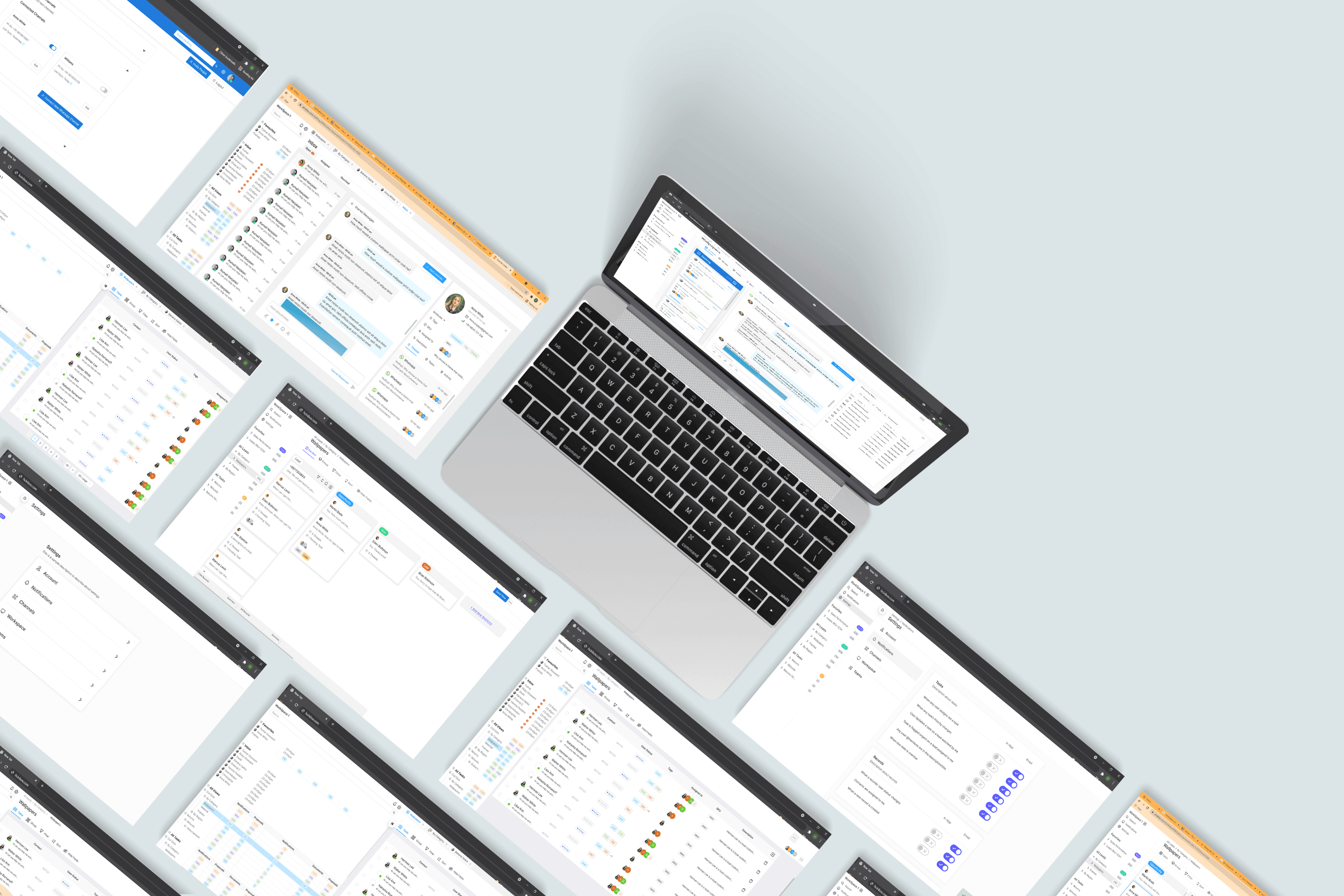
Goal
How might we increase financial literacy among prison leavers and reduce the number of individuals being recalled back to custody?
Themes
Social Impact
Service Design
Client Project
My Role
Service Designer
User Researcher
UI Designer
Storyteller
Methods & Tools
Service Blueprint
Co-creation
Trauma-informed Design
Stakeholder Map
Journey Mapping
Prototyping
Time Frame
11 weeks
Social Impact Lab is an exploratory project with the aim of increasing financial literacy among prison leavers and reducing the number of individuals being recalled back to custody.
It helps probation staff to build awareness and education around financial probation services among prison leavers as they are beginning their probation period.
The project is based upon 11 weeks of research and working closely with prison leavers and advisory staff, we have designed these interventions in the service to help facilitate improvement.
Social Impact Lab was created in partnership with Ministry of Justice, UK and Catch22, a not-for-profit social business that designs and delivers public services to people on probation in the UK, with a focus on building resilience within communities.
Over an 11-week period, we worked closely with prison leavers and Catch22’s staff. We conducted our own research to uncover new insights that can support Catch22 in improving its service.
Most recalls are preventable, which represents an important goal for all parties involved as it can significantly impact a Person on Probation's future prospects and mental health, deteriorates resettlement outcomes for probation services and is costly to the Ministry of Justice.
MoJ then decided to provide rehabilitation and reintegration services to people on probation through its partners, one of which is Catch22. Catch22 provides different services like justice, education, employability, reform etc. We worked with one of its services named FBD - Finance, Benefit and Debt service to people on probation.
As a team, we felt it was necessary to start this project by addressing how our shared values would shape the considerations we took in designing the various interviews we had. Particularly with People on Probation, many of whom may have experienced discrimination and trauma, we made sure to prioritise their well-being by acknowledging their presence and showing gratitude for their time and contribution to our project, which ultimately allowed us to define a solid framework for discussion by creating an environment that our interviewees felt comfortable in.
We gave special emphasis in understanding the backgrounds and cultures that most prisoners come from, noticing patterns of:
Being felt misunderstood while growing up
Coming from dysfunctional families
Influence of luxury products and brands as a status symbol
Experiencing poverty
Self expression through creative arts
Desire to prove
Exposure to violence since a young age
Racism and social exclusion/discrimination
Belonging to immigrant parents or being immigrants themselves
Comfort in chaos
Mob mentality and allegiance to their social circles
We made sure to avoid semblance in our process and interactions with people on probation which might trigger them of these instances and took great steps to make them feel safe and secure.
We also spoke with Financial and Wellbeing Advisors to understand the system from their perspective, and to identify any pain points that they may experience in their role. After organising and combining all of our findings, we categorised everything we had learned from each stakeholder’s perspective to identify all primary motivations and challenges.
Our three primary stakeholders are
People on Probation - POP
Financial and Wellbeing Advisors - FWAs
Probation Practitioners - PP
However, we realised that the relation and conduct between these three stakeholders is highly systemic and rooted in legal bindings, which is not possible for us to change.
We broadly are designing for two sets of users - POP and FWAs. We decided to look at the journey of the FBD service provided to a particular POP.
Once a criminal is sentenced to a prison, they go into Custody. After they complete half of their sentence in custody and if they had “good behaviour”, they are let out into society for reintegration and are to serve the remaining half their sentence in the real world. This phase is called probation. POP need to maintain some rules set out by MoJ which includes and is not limited to regular check in by the PP, attending educational programs, inability to travel to certain locations etc.
In this relationship, if the POP feels that they lack financial knowledge or if the PP feels that POP needs financial help, the PP refers the POP to FBD with a set of goals that the PP feels is necessary for the POP to achieve by the end of the FBD service.
FBD then has its first touchpoint with POP and they finalise the details for their first meeting. Post this call, an introduction pack is sent to the POP with a few legal documents for them to sign.
The initial assessment (IA) is conducted in the first meeting to gauge the existing financial knowledge and burden of the POP. Based on the results of the IA, together with the goals set out by the PP, a personalised action plan is created. This action plan is then followed for the next many weeks.
Once the advisory sessions are done, another final assessment is done to check the progress of the POP and the end of service report is drafted.
We analysed the journey map, dived deep into all the different processes, took some time getting accustomed to the acronyms and looked at each different document at FBD’s disposal.
We interviewed 3 POP and 3 FWAs to gauge their day-to-day and also to find out the gaps for disengagement.
After 4 weeks of primary and desk research, we found three gaps for improvement.
Advertising material is ineffective, and fails to engage and communicate the value of the service, leading to decreased visibility for FBD and those in need of its services.
The Initial Assessment purpose is a vague, scattered process, and difficult language makes it challenging for Advisors to navigate meetings and engage effectively with POP.
Action Plans in academic settings have been ineffective for POP's growth if their progress is not shown from custody to probation.
Based on our three insights, we came up with 3 possible interventions.
Enhanced Marketing Material
In our primary research, when we interviewed POP, one of them who said they were aware of the service but not sure what it is and another said after being referred to the service FBD realised he didn’t need it.
What already exists
What is lacking
Marketing flyers within custody
An introduction pack thats been sent to the POP before the initial assessment
An efficient way of communicating service value
Engaging language & visuals
Integrated Digital Tool
In our primary research, when we interviewed POP, one of them who said they were aware of the service but not sure what it is and another said after being referred to the service FBD realised he didn’t need it.
From this, we realised that FWAs don’t have much time and are engaged in non-advisory work with scattered documents.
What already exists
What is lacking
In person introduction
Screening call
User survey questionnaire on a tool called the PowerApp
Sustained efforts to keep the POP engaged
Repository of all the paperwork
Visibility of the value of the service
Reframed Action Plan
In our primary research, when we interviewed POP who have undergone the service, they said they felt like going through the service was a waste and they didn’t learn anything out of it.
From this, we realised that POP don’t know if they have made any progress as these are long term improvements.
What already exists
What is lacking
Outcomes and goals defined by the PP
Results of the service user questionnaire
PP’s case notes
Visible progress to the POP
Inability for the POP to have any say in the outcomes and goals
Non-integration of the learnings into real life
For this stage we had a limited time of 3 weeks where it was not possible for us to prototype and test all interventions. Hence, we decided to focus on our integrated digital tool and incorporate the ethos of invisibility of value in it.
For the purposes of prototyping and user testing, our problem statement changed.
By consolidating scattered elements of the initial assessment and implementing the agreed language, we aim to reduce time spent in the administrative process and improve engagement with POP.
In planning activities for our testing process, we utilised our desk research and key considerations in conjecture with our objectives.
Create a comfortable space for them by avoiding prison and school settings.
Promote Transparency in our objectives in order to have truthful responses & ask for their consent.
Promote freedom of choice in what activities they want to participate in and in what way.
Communicate the broader issue being addresses & how their contributions will help people on probation.
In facilitation of the workshop, the following activities were conducted:
Expectations from FWAs
Reality of FWAs
Supporting service user holistically
Administration work
Grow internal relations in Catch 22
Building relationships with stakeholders
Difficulty engaging POP & communicating with PP
Administrative tasks and paperwork are time consuming
“The current step-by-steps procedure is not efficient enough to spend more time to understand the situation.”
We confirmed that a mix of clear verbal and written language along with visual aids is the best method to deliver information, leading to improved engagement & understanding.
We found that the elements in the initial assessment have to be accessible at any point in the process. Certain documents have to be revisited to be reminded of boundaries & expectations. Also, the use of the tool can extend to the end of service as a way to measure progress.
We confirmed that resources for the Initial Assessment are often scattered, the purpose is vague, non-engaging & admin work is time consuming. Self assessment system in questionnaire doesn't provide space for accurate responses, restricting FWA from drafting effective action plans.
Incorporating the research was done during Discovery and the workshop, we proposed the following to Catch22 towards creating more value through their service.
Our digital tool helps FWAs who want to create meaningful and positive impact on POP’s financials by consolidating scattered and lengthy documents and revamping the language used unlike the current initial assessment.
Our revamped language help POP who want to gain the maximum out of the service by make all content relatable and easier to navigate unlike the current scattered documents.
POP facing interface
User-Centric Interface: The interface of our digital tool for POP was designed with a strong focus on user needs and requirements, ensuring a seamless experience for individuals navigating the post-probation process.
Flexibility and Personalization: POP users have the flexibility to start their journey from any section they are comfortable with, empowering them to engage with the tool at their own pace and based on their specific requirements.
Value-driven Introduction: In the introduction section, we prioritise expressing the value of the service, emphasising the positive impact it can have on the reintegration journey. Additionally, we showcase success stories that demonstrate the potential and possibilities offered by Catch22..
Streamlined Processes: We have incorporated features like a digital signature, which eliminates the need for paper-based documentation, reducing administrative burdens and enhancing efficiency in the probation process.
Minimalistic and Clear Content: Recognizing the importance of clarity, we have adopted a minimalistic approach, presenting information that is concise, easy to understand, and relevant. This approach helps users navigate the tool smoothly, ensuring a clear understanding of their obligations and responsibilities.
User-Friendly Form Design: In sections such as income and expenditure, where users are required to provide detailed information, we have divided the form into sections to avoid overwhelming users with information overload. Additionally, automated calculations simplify complex calculations, making the process more convenient and accurate.
Focus and Error Reduction: To maintain focus and minimize errors, we have designed the interface to present one question at a time. This approach guides users through the service-related questions, reducing cognitive load and enhancing accuracy.
Interactive Engagement: We have implemented interactive elements, such as sliders, to make the experience engaging for users. For instance, when users rate themselves on certain criteria, we provide an optional space for them to provide additional context or elaboration on their ratings. This encourages active participation and allows for better understanding and collaboration between users and probation advisors.
POP Interface - Clickable Prototype
Admin panel interface
Our digital tool features a robust admin panel specifically designed to meet the unique needs of Financial and Wellbeing Advisors (FWA). This comprehensive interface streamlines administrative tasks, enhances communication, and ensures seamless management of casework for individuals on probation.
Centralised Communication Hub: Our admin panel serves as a one-stop solution for internal communication, providing FWA with a dedicated platform to collaborate, exchange information, and stay connected with their team members.
Comprehensive POP Database: FWA can effortlessly access and maintain a comprehensive database of all POP. This centralised repository enables efficient record management, ensuring vital information is readily available whenever needed.
Effortless Meeting Management: FWA's daily meetings, whether online or in person, with teammates or with POP, are made hassle-free through our integrated scheduler. With the necessary POP information conveniently accessible within the admin panel, scheduling, tracking, and organising meetings becomes seamless.
Streamlined Invoicing: It includes an integrated invoicing feature that simplifies the tracking of reimbursement invoices, travel-related expenses, and other financial transactions. FWA can easily generate, manage, and track invoices, streamlining administrative processes.
Comprehensive Casework Management: It provides FWA with a comprehensive view of all casework related to every POP. This holistic overview ensures efficient case management, allowing FWA to access and update relevant information with ease.
Moreover, our admin panel is designed with scalability in mind, adapting to the evolving needs of FBD. Its flexibility allows for future expansion and customisation to accommodate the growing requirements of FBD, ensuring a sustainable and adaptable solution.
We have received positive feedback for our proposal.
We are currently in talks with Catch22 to integrate our proposal into their process.
Further updates will be added.
